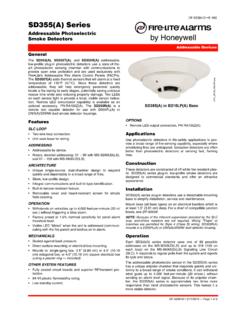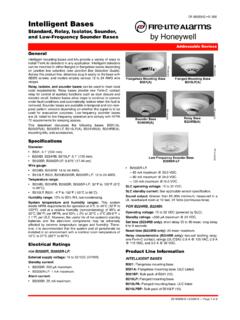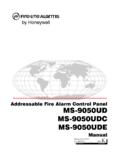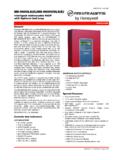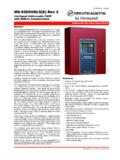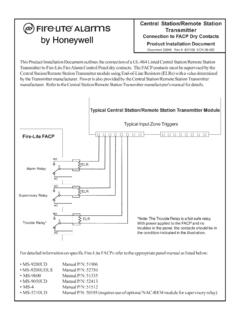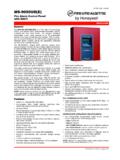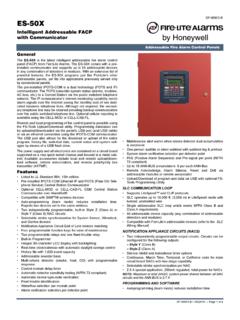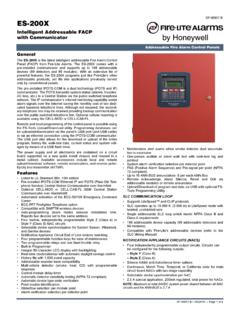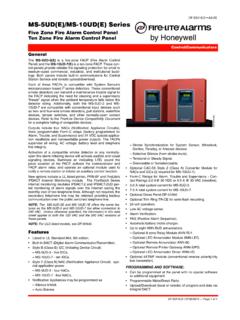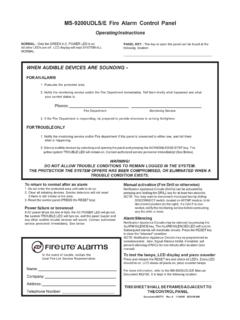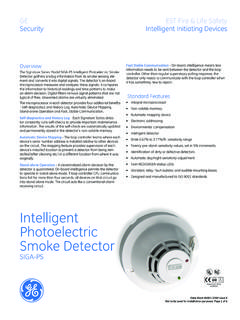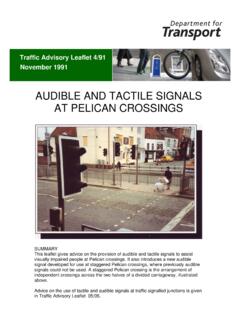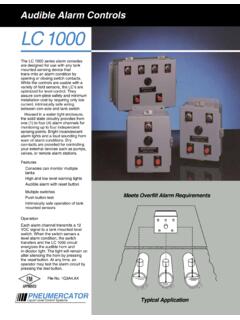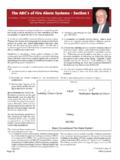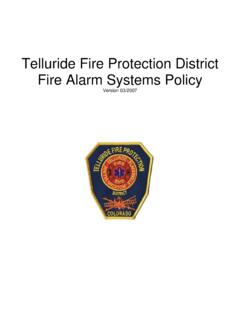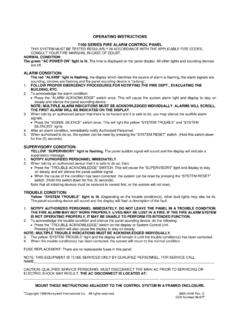Transcription of Wiring Manual - Fire-Lite Alarms
1 intelligent control Panel SLC. Wiring Manual Document 51309 Rev: P9. 7/26/2018 ECN:18-323. Fire Alarm & Emergency Communication System Limitations While a life safety system may lower insurance rates, it is not a substitute for life and property insurance! An automatic fire alarm system typically made up of smoke (caused by escaping gas, improper storage of flammable materi- detectors, heat detectors, Manual pull stations, audible warning als, etc.). devices, and a fire alarm control panel (FACP) with remote notifi- Heat detectors do not sense particles of combustion and alarm cation capability can provide early warning of a developing fire. only when heat on their sensors increases at a predetermined Such a system, however, does not assure protection against rate or reaches a predetermined level.
2 Rate-of-rise heat detec- property damage or loss of life resulting from a fire. tors may be subject to reduced sensitivity over time. For this rea- An emergency communication system typically made up of son, the rate-of-rise feature of each detector should be tested at an automatic fire alarm system (as described above) and a life least once per year by a qualified fire protection specialist. Heat safety communication system that may include an autonomous detectors are designed to protect property, not life. control unit (ACU), local operating console (LOC), voice commu- IMPORTANT! Smoke detectors must be installed in the same nication, and other various interoperable communication meth- room as the control panel and in rooms used by the system for ods can broadcast a mass notification message. Such a the connection of alarm transmission Wiring , communications, system, however, does not assure protection against property signaling, and/or power.
3 If detectors are not so located, a devel- damage or loss of life resulting from a fire or life safety event. oping fire may damage the alarm system, compromising its abil- The Manufacturer recommends that smoke and/or heat ity to report a fire. detectors be located throughout a protected premises following Audible warning devices such as bells, horns, strobes, the recommendations of the current edition of the National Fire speakers and displays may not alert people if these devices Protection Association Standard 72 (NFPA 72), manufacturer's are located on the other side of closed or partly open doors or recommendations, State and local codes, and the are located on another floor of a building. Any warning device recommendations contained in the Guide for Proper Use of may fail to alert people with a disability or those who have System Smoke Detectors, which is made available at no charge recently consumed drugs, alcohol, or medication.
4 Please note to all installing dealers. This document can be found at http:// that: A study by the Federal An emergency communication system may take priority over Emergency Management Agency (an agency of the United a fire alarm system in the event of a life safety emergency. States government) indicated that smoke detectors may not go off in as many as 35% of all fires. While fire alarm systems are Voice messaging systems must be designed to meet intelligi- designed to provide early warning against fire, they do not bility requirements as defined by NFPA, local codes, and guarantee warning or protection against fire. A fire alarm system Authorities Having Jurisdiction (AHJ). may not provide timely or adequate warning, or simply may not Language and instructional requirements must be clearly dis- function, for a variety of reasons: seminated on any local displays.
5 Smoke detectors may not sense fire where smoke cannot Strobes can, under certain circumstances, cause seizures in reach the detectors such as in chimneys, in or behind walls, on people with conditions such as epilepsy. roofs, or on the other side of closed doors. Smoke detectors also Studies have shown that certain people, even when they hear may not sense a fire on another level or floor of a building. A sec- a fire alarm signal, do not respond to or comprehend the ond-floor detector, for example, may not sense a first-floor or meaning of the signal. Audible devices, such as horns and basement fire. bells, can have different tonal patterns and frequencies. It is Particles of combustion or smoke from a developing fire the property owner's responsibility to conduct fire drills and may not reach the sensing chambers of smoke detectors other training exercises to make people aware of fire alarm because: signals and instruct them on the proper reaction to alarm sig- Barriers such as closed or partially closed doors, walls, chim- nals.
6 Neys, even wet or humid areas may inhibit particle or smoke In rare instances, the sounding of a warning device can cause flow. temporary or permanent hearing loss. Smoke particles may become cold, stratify, and not reach A life safety system will not operate without any electrical the ceiling or upper walls where detectors are located. power. If AC power fails, the system will operate from standby Smoke particles may be blown away from detectors by air batteries only for a specified time and only if the batteries have outlets, such as air conditioning vents. been properly maintained and replaced regularly. Smoke particles may be drawn into air returns before reach- Equipment used in the system may not be technically compat- ing the detector. ible with the control panel. It is essential to use only equipment listed for service with your control panel.
7 The amount of smoke present may be insufficient to alarm smoke detectors. Smoke detectors are designed to alarm at var- Telephone lines needed to transmit alarm signals from a prem- ious levels of smoke density. If such density levels are not cre- ises to a central monitoring station may be out of service or tem- ated by a developing fire at the location of detectors, the porarily disabled. For added protection against telephone line detectors will not go into alarm. failure, backup radio transmission systems are recommended. Smoke detectors, even when working properly, have sensing The most common cause of life safety system malfunction is limitations. Detectors that have photoelectronic sensing cham- inadequate maintenance. To keep the entire life safety system in bers tend to detect smoldering fires better than flaming fires, excellent working order, ongoing maintenance is required per the which have little visible smoke.
8 Detectors that have ionizing-type manufacturer's recommendations, and UL and NFPA standards. sensing chambers tend to detect fast-flaming fires better than At a minimum, the requirements of NFPA 72 shall be followed. smoldering fires. Because fires develop in different ways and are Environments with large amounts of dust, dirt, or high air velocity often unpredictable in their growth, neither type of detector is require more frequent maintenance. A maintenance agreement necessarily best and a given type of detector may not provide should be arranged through the local manufacturer's representa- adequate warning of a fire. tive. Maintenance should be scheduled as required by National and/or local fire codes and should be performed by authorized Smoke detectors cannot be expected to provide adequate warn- professional life safety system installers only.
9 Adequate written ing of fires caused by arson, children playing with matches records of all inspections should be kept. (especially in bedrooms), smoking in bed, and violent explosions Limit-D2-2016. 2 FireLite SLC Wiring Manual P/N 51309:P9 7/26/2018. Installation Precautions Adherence to the following will aid in problem-free installation with long-term reliability: WARNING - Several different sources of power can be Like all solid state electronic devices, this system may connected to the fire alarm control panel. Disconnect all operate erratically or can be damaged when subjected to light- sources of power before servicing. control unit and associated ning induced transients. Although no system is completely equipment may be damaged by removing and/or inserting immune from lightning transients and interference, proper cards, modules, or interconnecting cables while the unit is grounding will reduce susceptibility.
10 Overhead or outside aerial energized. Do not attempt to install, service, or operate this Wiring is not recommended, due to an increased susceptibility unit until manuals are read and understood. to nearby lightning strikes. Consult with the Technical Ser- CAUTION - System Re-acceptance Test after Software vices Department if any problems are anticipated or encoun- Changes: To ensure proper system operation, this product tered. must be tested in accordance with NFPA 72 after any pro- Disconnect AC power and batteries prior to removing or gramming operation or change in site-specific software. Re- inserting circuit boards. Failure to do so can damage circuits. acceptance testing is required after any change, addition or Remove all electronic assemblies prior to any drilling, filing, deletion of system components, or after any modification, reaming, or punching of the enclosure.
